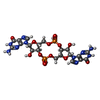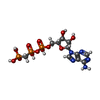[English] 日本語
 Yorodumi
Yorodumi- PDB-8pb9: Cryo-EM structure of the c-di-GMP-bound FleQ-FleN master regulato... -
+ Open data
Open data
- Basic information
Basic information
| Entry | Database: PDB / ID: 8pb9 | |||||||||||||||||||||||||||
|---|---|---|---|---|---|---|---|---|---|---|---|---|---|---|---|---|---|---|---|---|---|---|---|---|---|---|---|---|
| Title | Cryo-EM structure of the c-di-GMP-bound FleQ-FleN master regulator complex from Pseudomonas aeruginosa | |||||||||||||||||||||||||||
 Components Components |
| |||||||||||||||||||||||||||
 Keywords Keywords | GENE REGULATION / Biofilm formation / c-di-GMP signaling / second messengers / bacterial secretion / bEBPs | |||||||||||||||||||||||||||
| Function / homology |  Function and homology information Function and homology informationpositive regulation of cilium-dependent cell motility / regulation of bacterial-type flagellum-dependent cell motility / cyclic-di-GMP binding / positive regulation of cell-substrate adhesion / negative regulation of extracellular matrix assembly / DNA-binding transcription repressor activity / DNA-binding transcription activator activity / cis-regulatory region sequence-specific DNA binding / protein-DNA complex / cytoplasmic side of plasma membrane ...positive regulation of cilium-dependent cell motility / regulation of bacterial-type flagellum-dependent cell motility / cyclic-di-GMP binding / positive regulation of cell-substrate adhesion / negative regulation of extracellular matrix assembly / DNA-binding transcription repressor activity / DNA-binding transcription activator activity / cis-regulatory region sequence-specific DNA binding / protein-DNA complex / cytoplasmic side of plasma membrane / transcription cis-regulatory region binding / DNA-templated transcription / regulation of DNA-templated transcription / positive regulation of DNA-templated transcription / ATP hydrolysis activity / ATP binding / cytosol Similarity search - Function | |||||||||||||||||||||||||||
| Biological species |  Pseudomonas aeruginosa PAO1 (bacteria) Pseudomonas aeruginosa PAO1 (bacteria) | |||||||||||||||||||||||||||
| Method | ELECTRON MICROSCOPY / single particle reconstruction / cryo EM / Resolution: 3.3 Å | |||||||||||||||||||||||||||
 Authors Authors | Torres-Sanchez, L.T. / Krasteva, P.V. | |||||||||||||||||||||||||||
| Funding support | European Union, 1items
| |||||||||||||||||||||||||||
 Citation Citation |  Journal: Proc Natl Acad Sci U S A / Year: 2023 Journal: Proc Natl Acad Sci U S A / Year: 2023Title: Structures of the FleQ-FleN master regulators reveal large-scale conformational switching in motility and biofilm control. Authors: Lucía Torres-Sánchez / Thibault Géry Sana / Marion Decossas / Yaser Hashem / Petya Violinova Krasteva /  Abstract: can cause a wide array of chronic and acute infections associated with its ability to rapidly switch between planktonic, biofilm, and dispersed lifestyles, each with a specific arsenal for bacterial ... can cause a wide array of chronic and acute infections associated with its ability to rapidly switch between planktonic, biofilm, and dispersed lifestyles, each with a specific arsenal for bacterial survival and virulence. At the cellular level, many of the physiological transitions are orchestrated by the intracellular second messenger c-di-GMP and its receptor-effector FleQ. A bacterial enhancer binding protein, FleQ acts as a master regulator of both flagellar motility and adherence factor secretion and uses remarkably different transcription activation mechanisms depending on its dinucleotide loading state, adenosine triphosphatase (ATPase) activity, interactions with polymerase sigma (σ) factors, and complexation with a second ATPase, FleN. How the FleQ-FleN tandem can exert diverse effects through recognition of a conserved FleQ binding consensus has remained enigmatic. Here, we provide cryogenic electron microscopy (cryo-EM) structures of both c-di-GMP-bound and c-di-GMP-free FleQ-FleN complexes which deepen our understanding of the proteins' (di)nucleotide-dependent conformational switching and fine-tuned roles in gene expression regulation. | |||||||||||||||||||||||||||
| History |
|
- Structure visualization
Structure visualization
| Structure viewer | Molecule:  Molmil Molmil Jmol/JSmol Jmol/JSmol |
|---|
- Downloads & links
Downloads & links
- Download
Download
| PDBx/mmCIF format |  8pb9.cif.gz 8pb9.cif.gz | 313.7 KB | Display |  PDBx/mmCIF format PDBx/mmCIF format |
|---|---|---|---|---|
| PDB format |  pdb8pb9.ent.gz pdb8pb9.ent.gz | 248.4 KB | Display |  PDB format PDB format |
| PDBx/mmJSON format |  8pb9.json.gz 8pb9.json.gz | Tree view |  PDBx/mmJSON format PDBx/mmJSON format | |
| Others |  Other downloads Other downloads |
-Validation report
| Summary document |  8pb9_validation.pdf.gz 8pb9_validation.pdf.gz | 1.3 MB | Display |  wwPDB validaton report wwPDB validaton report |
|---|---|---|---|---|
| Full document |  8pb9_full_validation.pdf.gz 8pb9_full_validation.pdf.gz | 1.3 MB | Display | |
| Data in XML |  8pb9_validation.xml.gz 8pb9_validation.xml.gz | 55.5 KB | Display | |
| Data in CIF |  8pb9_validation.cif.gz 8pb9_validation.cif.gz | 83.8 KB | Display | |
| Arichive directory |  https://data.pdbj.org/pub/pdb/validation_reports/pb/8pb9 https://data.pdbj.org/pub/pdb/validation_reports/pb/8pb9 ftp://data.pdbj.org/pub/pdb/validation_reports/pb/8pb9 ftp://data.pdbj.org/pub/pdb/validation_reports/pb/8pb9 | HTTPS FTP |
-Related structure data
| Related structure data |  17581MC  8p53C C: citing same article ( M: map data used to model this data |
|---|---|
| Similar structure data | Similarity search - Function & homology  F&H Search F&H Search |
- Links
Links
- Assembly
Assembly
| Deposited unit | 
|
|---|---|
| 1 |
|
- Components
Components
| #1: Protein | Mass: 44884.316 Da / Num. of mol.: 3 Source method: isolated from a genetically manipulated source Details: FleQ-receiver and AAA+ domains of Pseudomonas aeruginosa FleQ Source: (gene. exp.)  Pseudomonas aeruginosa PAO1 (bacteria) / Gene: fleQ, PA1097 / Production host: Pseudomonas aeruginosa PAO1 (bacteria) / Gene: fleQ, PA1097 / Production host:  #2: Protein | Mass: 30327.141 Da / Num. of mol.: 2 / Mutation: D48A Source method: isolated from a genetically manipulated source Details: Pseudomonas aeruginosa FleN D48A mutant / Source: (gene. exp.)  Pseudomonas aeruginosa PAO1 (bacteria) / Gene: fleN, PA1454 / Production host: Pseudomonas aeruginosa PAO1 (bacteria) / Gene: fleN, PA1454 / Production host:  #3: Chemical | #4: Chemical | Has ligand of interest | Y | Has protein modification | N | |
|---|
-Experimental details
-Experiment
| Experiment | Method: ELECTRON MICROSCOPY |
|---|---|
| EM experiment | Aggregation state: PARTICLE / 3D reconstruction method: single particle reconstruction |
- Sample preparation
Sample preparation
| Component | Name: C-di-GMP bound FleQ-FleN complex from Pseudomonas aeruginosa Type: COMPLEX Details: C-di-GMP bound complex between FleQ REC and AAA+ domains and FleN D48A mutant from Pseudomonas aeruginosa Entity ID: #1-#2 / Source: RECOMBINANT |
|---|---|
| Molecular weight | Value: 0.233 MDa / Experimental value: NO |
| Source (natural) | Organism:  Pseudomonas aeruginosa PAO1 (bacteria) Pseudomonas aeruginosa PAO1 (bacteria) |
| Source (recombinant) | Organism:  |
| Buffer solution | pH: 8 Details: 20 mM HEPES pH 8.0, 250mM NaCl, 2mM MgCl2, and 2% glycerol, 4 uM c-di-GMP, 200 uM ACP |
| Specimen | Embedding applied: NO / Shadowing applied: NO / Staining applied: NO / Vitrification applied: YES Details: FleN-D48A and FleQ (REC-AAA+) coexpression from the pProEx-Htb and pRSFDuet1 vectors. Purified via the HRV3c- cleavable N-terminal hexahistidine tag on FleN |
| Specimen support | Grid material: GOLD / Grid type: UltrAuFoil R1.2/1.3 |
| Vitrification | Instrument: FEI VITROBOT MARK IV / Cryogen name: ETHANE / Humidity: 100 % / Chamber temperature: 277 K / Details: triple deposition |
- Electron microscopy imaging
Electron microscopy imaging
| Experimental equipment |  Model: Titan Krios / Image courtesy: FEI Company |
|---|---|
| Microscopy | Model: FEI TITAN KRIOS |
| Electron gun | Electron source:  FIELD EMISSION GUN / Accelerating voltage: 300 kV / Illumination mode: FLOOD BEAM FIELD EMISSION GUN / Accelerating voltage: 300 kV / Illumination mode: FLOOD BEAM |
| Electron lens | Mode: BRIGHT FIELD / Nominal defocus max: 2000 nm / Nominal defocus min: 800 nm / Cs: 2.7 mm |
| Image recording | Electron dose: 50.3 e/Å2 / Film or detector model: GATAN K3 BIOQUANTUM (6k x 4k) / Num. of grids imaged: 1 / Num. of real images: 14640 |
| Image scans | Width: 5760 / Height: 4092 |
- Processing
Processing
| EM software |
| ||||||||||||||||||||||||||||
|---|---|---|---|---|---|---|---|---|---|---|---|---|---|---|---|---|---|---|---|---|---|---|---|---|---|---|---|---|---|
| CTF correction | Details: Gctf through cryoSPARC interface / Type: PHASE FLIPPING AND AMPLITUDE CORRECTION | ||||||||||||||||||||||||||||
| Symmetry | Point symmetry: C1 (asymmetric) | ||||||||||||||||||||||||||||
| 3D reconstruction | Resolution: 3.3 Å / Resolution method: OTHER / Num. of particles: 1283732 Details: Due to flexibility, preferential orientation and partial occupancy for one of the subunits, the data was downsampled and the resolution used for refinement was cut to 3.3 angstrom after Deep EMhancer sharpening. Num. of class averages: 1 / Symmetry type: POINT | ||||||||||||||||||||||||||||
| Atomic model building |
| ||||||||||||||||||||||||||||
| Atomic model building |
| ||||||||||||||||||||||||||||
| Refine LS restraints |
|
 Movie
Movie Controller
Controller



 PDBj
PDBj









